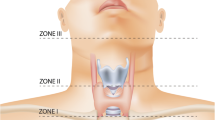Abstract
Purpose
Vascular injury in penetrating neck trauma predicts a poorer outcome and usually requires surgical neck exploration. Multi-detector computed tomography (MDCT) angiography is a readily available non-invasive diagnostic tool that can identify direct and indirect signs of vascular injury in stable patients. This study aims to investigate the diagnostic accuracy of radiological signs of vascular injury on MDCT, and their implications on patient management in the setting of penetrating neck trauma.
Methods
A retrospective cohort study of penetrating neck injuries (PNI) between 2012 and 2018 in a UK major trauma centre was performed. Clinical data and operative findings were compared with radiological findings on MDCT performed at the time of admission.
Results
157 patients were identified with PNI in the study period, with 67 meeting inclusion criteria. The predictive value of indirect radiological signs of vascular injury alone was low, with only 12.1% of these patients having significant vascular injury found at neck exploration. However, the combined use of direct radiological signs with clinical signs resulted in a specificity of 97.7% for vascular injury.
Conclusions
The use of direct and indirect radiological signs of vascular injury can increase the accuracy of diagnosis when used in conjunction with clinical signs. Combining clinical assessment and radiological investigation, specifically contrast-enhanced MDCT, improves the specificity in pre-operative assessment of potential vascular injury in PNI. MDCT is recommended in stable patients with clinical signs of vascular injury to reduce the rate of negative neck exploration.





Similar content being viewed by others
References
Sperry JL, Moore EE, Coimbra R, Croce M, Davis JW, Karmy-Jones R, McIntyre RC Jr, Moore FA, Malhotra A, Shatz DV, Biffl WL (2013) Western trauma association critical decisions in trauma: penetrating neck trauma. J Trauma Acute Care Surg 75:936–940
Nason RW, Assuras GN, Gray PR, Lipschitz J (2001) Penetrating neck injuries: analysis of experience from a Canadian trauma centre Canadian Journal of Surgery. Journal Canadien de Chirurgie 44:122–126
Steenburg SD, Sliker CW, Shanmuganathan K, Siegel EL (2010) Imaging evaluation of penetrating neck injuries. RadioGraphics 30:869–886
Monson DO, Saletta JD, Freeark RJ (1969) Carotid vertebral trauma. J Trauma 9:987–999
Roon AJ, Christensen N (1979) Evaluation and treatment of penetrating cervical injuries. J Trauma 19:391–397
Prichayudh S, Choadrachata-anun J, Sriussadaporn S, Pak-art R, Sriussadaporn S, Kritayakirana K, Samorn P (2015) Selective management of penetrating neck injuries using “no zone” approach. Injury 46(9):1720–1725
Ibraheem K, Khan M, Rhee P, Azim A, O'Keeffe T, Tang A, Kulvatunyou N, Joseph B (2018) “No zone” approach in penetrating neck trauma reduces unnecessary computed tomography angiography and negative explorations. J Surg Res 221:113–120
Woo K, Magner DP, Wilson MT, Margulies DR (2005) CT angiography in penetrating neck trauma reduces the need for operative neck exploration. Am Surg 71:754–758
Kendall JL, Anglin D, Demetriades D (1998) Penetrating neck trauma. Emerg Med Clin North Am 16:85–105
Múnera F, Soto JA, Palacio DM, Castaneda J, Morales C, Sanabria A, Gutierrez JE, Garcia G (2002) Penetrating neck injuries: helical CT angiography for initial evaluation. Radiology 224:366–372
Núñez DB, Torres-León M, Múnera F (2004) Vascular injuries of the neck and thoracic inlet: helical CT–angiographic correlation. RadioGraphics 24:1087–1098
Demetriades D, Velmahos GG, Asensio JA (2001) Cervical pharyngoesophageal and laryngotracheal injuries. World J Surg 25:1044–1048
Mahmoodie M, Sanei B, Moazeni-Bistgani M, Namgar M (2012) Penetrating neck trauma: review of 192 cases. Arch Trauma Res 1:14–18
Bodanapally UK, Shanmuganathan K, Dreizin D, Stein D, Reddy AK, Mirvis SE, Vasquez M, Cardarelli C, Guardiani E (2016) Penetrating aerodigestive injuries in the neck: a proposed CT-aided modified selective management algorithm. Eur Radiol 26:2409–2417
Olding J, Olding C, Fan K, Bew D (2019) Penetrating head & neck trauma–Epidemiology and injury characteristics in terror-related violence, interpersonal violence and deliberate self-harm at a level 1 trauma centre. The Surgeon Feb 23
Siau RT, Moore A, Ahmed T, Lee MS, Tostevin P (2013) Management of penetrating neck injuries at a London trauma centre. Eur Arch Otorhinolaryngol 270:2123–2128
Inaba K, Munera F, McKenney M, Rivas L, de Moya M, Bahouth H, Cohn S (2006) Prospective evaluation of screening multislice helical CTA in the initial evaluation of penetrating neck injuries. J Trauma Injury Infection Crit Care 61:144–156
Schroll R, Fontenot T, Lipcsey M, Heaney JB, Marr A, Meade P, McSwain N, Duchesne J (2015) Role of computed tomography angiography in the management of Zone II penetrating neck trauma in patients with clinical hard signs. J Trauma Acute Care Surg 79:943–950
Bell RB, Osborn T, Dierks EJ, Potter BE, Long WB (2007) Management of penetrating neck injuries: a new paradigm for civilian trauma. J Oral Maxillofac Surg 65:691–705
Múnera F, Soto JA, Palacio D, Velez SM, Medina E (2000) Diagnosis of arterial injuries caused by penetrating trauma to the neck: comparison of helical CT angiography and conventional angiography. Radiology 216:356–362
Osborn TM, Bell RB, Qaisi W, Long WB (2008) Computed tomographic angiography as an aid to clinical decision making in the selective management of penetrating injuries to the neck: a reduction in the need for operative exploration. J Trauma 64:1466–1471
Nasr A, Oliviera JT, Mazepa MM, Albuquerque CL, Martini GS, Nazario M, Carvalho FH (2015) Evaluation of the use of tomography in penetrating neck trauma. Revista do Colégio Brasileiro de CirurgiõesAug 42:215–219
Funding
The authors declare that they have no sources of funding.
Author information
Authors and Affiliations
Corresponding author
Ethics declarations
Conflict of interest
The authors declare that they have no conflict of interest.
Additional information
Publisher's Note
Springer Nature remains neutral with regard to jurisdictional claims in published maps and institutional affiliations.
Rights and permissions
About this article
Cite this article
Borsetto, D., Fussey, J., Mavuti, J. et al. Penetrating neck trauma: radiological predictors of vascular injury. Eur Arch Otorhinolaryngol 276, 2541–2547 (2019). https://doi.org/10.1007/s00405-019-05517-2
Received:
Accepted:
Published:
Issue Date:
DOI: https://doi.org/10.1007/s00405-019-05517-2




